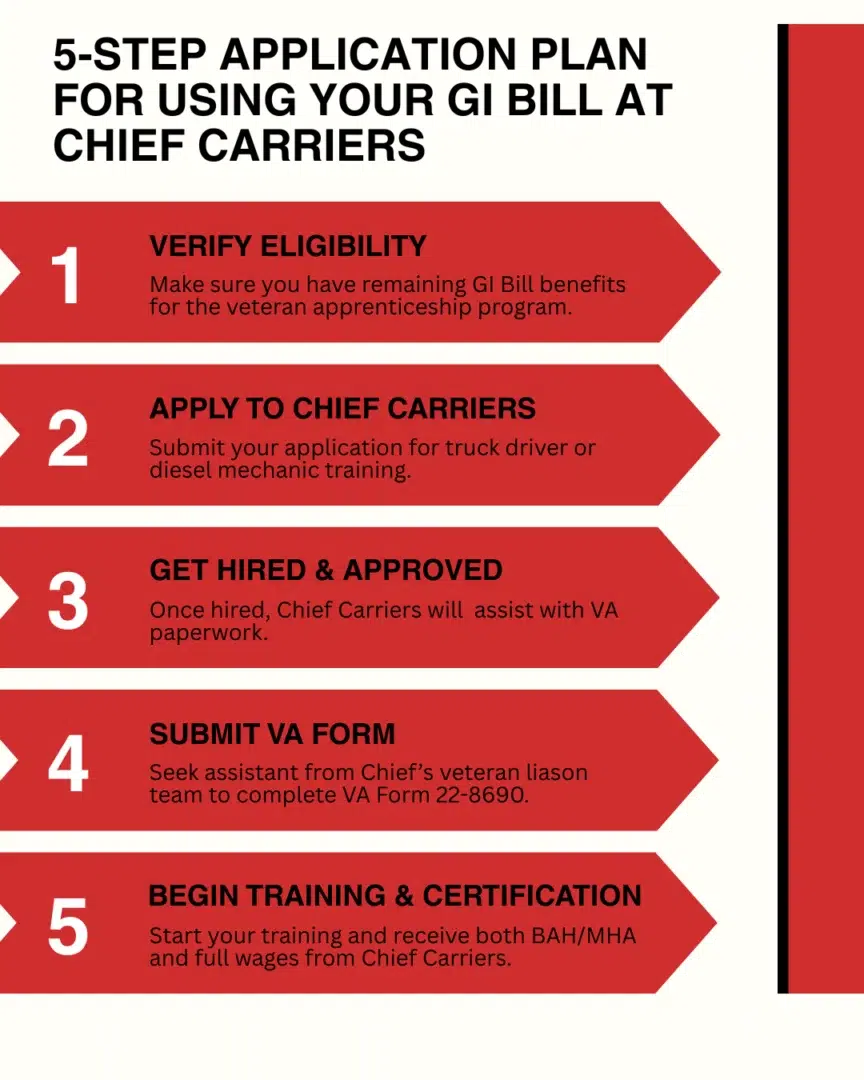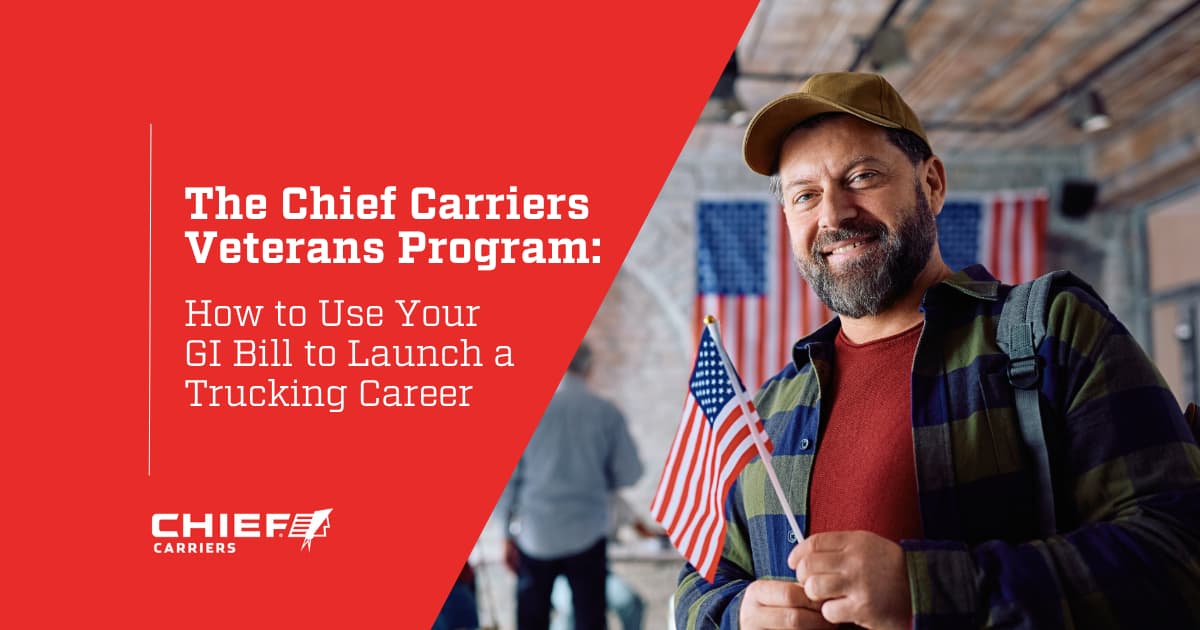A Guide for Using Your GI Bill Benefits at Chief Carriers
For many veterans, their GI Bill represents a promise of financial stability; however, traditional schooling often delays high earnings and forces temporary financial compromises. Knowing how to use your GI Bill education benefits strategically can help you launch a high-paying career in the trucking and logistics industry and earn a paycheck from day one.
At Chief Carriers, our Veterans Apprenticeship Program is the most direct and financially advantageous route to becoming a professional flatbed driver or diesel mechanic, offering a dual financial advantage. We’ll walk you through using your GI Bill benefits to immediately earn full training wages plus a tax-free monthly housing allowance during your on-the-job training.

GI Bill for On-the-Job Training: Your Dual Financial Advantage
The key to unlocking this financial stability lies in understanding the difference between using the GI Bill for traditional college courses and using your GI Bill for on-the-job training (OJT).
While traditional colleges focus on classroom learning, a VA-approved veteran apprenticeship program emphasizes structured, employer-led training. The VA provides monthly financial benefits directly to the veteran while they are enrolled in an approved program.
The GI Bill Housing Allowance (BAH/MHA)
The GI Bill housing allowance (MHA), often referred to as BAH, is the critical financial differentiator for veterans in the Chief Carriers apprenticeship. This tax-free stipend is calculated based on the Post-9/11 GI Bill rate for an E-5 with dependents at the training location’s ZIP code (or the designated main campus ZIP code) and is paid directly to the veteran each month.
How the Stipend Works During Training
- Initial Rate: The stipend begins at 100% of the applicable rate for the first six months of training.
- The Stipend Taper: The monthly stipend gradually tapers down every six months. For instance, in a two-year program, it might step down to 80%, then 60%, and finally 40%.
Why the Stipend Tapers
The decrease is designed to coincide with the veteran’s full training wages increasing as their skills improve and they take on greater responsibility. By the time the stipend ends, the veteran is earning a full, professional-level salary.
The stability of the combined wage and GI Bill housing allowance is crucial for veterans establishing a financial foundation during their transition from military service to trucking.
We have to follow the guidelines of the government and document all the working hours that veterans have done for us, as they’re moving through the apprenticeship program, so that they are getting the full benefits.
-Mandee Lade, Chief Carriers Recruiter

Financial Benefit Comparison: School vs. Apprenticeship
Unlike traditional truck driving schools that require you to spend your GI Bill benefits on tuition and leave you without a salary during training, the Chief Carriers program lets you keep your benefits and receive full wages from day one. This employer-paid training, combined with a monthly, tax-free VA stipend, creates a powerful dual income stream.
This dual-income structure fundamentally changes the military transition to trucking because you’re not sacrificing immediate income to use your education benefits
The GI Bill is something that every military member gets… You get your education paid for, but you also get a housing allowance to pay for your living situation while [you’re in school].
-Andrew Winkler, General Manager of Chief Carriers

How to Use Your GI Bill: A 5-Step Application Plan
Enrolling in the Chief Carriers veteran apprenticeship program is a streamlined process designed to quickly place you in a paying role. Here is the step-by-step process for using your GI bill education benefits for this path.
- Verify Eligibility: Ensure you have remaining GI Bill education benefits (Post-9/11 GI Bill or Montgomery GI Bill) that can be used for the veteran apprenticeship program.
- Apply to Chief Carriers: Submit your application for the flatbed driver or diesel mechanic training role. The application clearly identifies the path for veterans seeking to use their benefits.
- Get Hired & Approved: Once you are hired, Chief Carriers helps submit the necessary VA paperwork, confirming your enrollment in their VA-approved program.
- Submit VA Form: Complete VA Form 22-8690, Application for OJT or Apprenticeship, with assistance from the Chief Carriers veteran liaison team.
Begin Training & Certification: Start your paid, on-the-job training and officially begin receiving your monthly tax-free BAH/MHA stipend from the VA, in addition to your full Chief Carriers wages.

Expediting Your CDL: The Military Skills Test Waiver
A key benefit Chief Carriers prioritizes for eligible veterans is the military skills test waiver. Veterans who have operated heavy vehicles in the military (e.g., specific MOS/ratings) may qualify to have the road skills portion of the Commercial Driver’s License (CDL) test waived.
This simple step can save veterans weeks in the training process, enabling them to become professional drivers more quickly and start earning a full driver’s salary sooner. Chief Carriers has dedicated personnel to help identify eligibility and process this waiver quickly.
RELATED: Market Trend Insights: Nebraska’s Oversized Flatbed Loads
The Power of Veteran Mentorship
Another essential component of the program is the veteran mentor network, whereby Chief Carriers ensures every veteran apprentice is paired with an experienced driver or mechanic who has a military background.
These mentors help translate skills veterans bring to trucking, such as discipline, attention to detail, and mission focus, directly into a successful civilian career path. This structured support system is critical for a smooth post-military transition to trucking.
I would say there’s a lot of great skills that veterans would bring to the table… leadership under pressure. Also, accountability, adaptability, and having a strong work ethic.
-Staff Sergeant Chris Chambers, US Air Force

Beyond the Stipend: Launching True Trucking Careers for Veterans
Many veterans ask, “Can I use the GI Bill to pay for truck driving school?” While the answer is often yes, that approach results in non-OJT schools costing your tuition benefits and only providing a minimal monthly stipend.
High-Cost Schooling vs. a Debt-Free Path
The conventional wisdom suggests using the GI Bill to pay tuition for any civilian schooling. However, for a high-demand trade like trucking, this often translates to paying high tuition to a private, non-OJT truck school, leaving the veteran with no paycheck during training.
A different perspective suggests leveraging the GI Bill for on-the-job training to prioritize immediate financial stability and career progression. The Chief Carriers apprenticeship is a powerful alternative.
The apprenticeship model means Chief Carriers pays for all training, preserving your benefits while you earn a full salary and receive a supplemental, tax-free housing stipend. This approach ensures a debt-free education and leads directly to a high-paying career.
Veterans completing our apprenticeship program achieved an average salary that is 15% higher within their first 18 months post-completion compared to peers who went through traditional schooling.

GI Bill Apprenticeship FAQs: Your Questions Answered
This section clarifies common questions about how the OJT structure works, particularly the GI Bill housing allowance during a trucking apprenticeship.
How long does the GI Bill housing allowance last during the apprenticeship?
The stipend is paid for the entire duration of the VA-approved program (typically 12-24 months for a professional driver or diesel mechanic training role). The amount gradually decreases every six months as your full training wages increase.
Can I use the Post-9/11 GI Bill or the Montgomery GI Bill (MGIB)?
Yes, the Chief Carriers apprenticeship programs for veterans are approved for both the Post-9/11 GI Bill (Chapter 33) and the Montgomery GI Bill (Chapter 30).
Is the VA-approved apprenticeship only for drivers?
While the flatbed driving program is the most popular, Chief Carriers also has a VA-approved OJT path for diesel mechanic training, offering a similar dual-income benefit structure and a high-demand veteran career path in logistics and transportation.
RELATED: Repairs and Maintenance: Keeping Truck Fleets on the Road
How does the GI Bill apprenticeship program work for trucking?
It works by categorizing your on-the-job training as an approved “educational pursuit.” You receive full wages from Chief Carriers for your work, and the VA pays a monthly, tax-free stipend (BAH/MHA) to offset living costs during your training period.

Start Earning Today: Your Debt-Free Trucking Future
Chief Carriers provides the premier avenue to capitalize on the demand for former service members by leveraging your GI Bill education benefits for immediate financial gain. The trucking industry needs the skills acquired during military service, and GI Bill benefits can serve as a catalyst to launch trucking careers for veterans without incurring student debt.
Take the next step and learn more about flatbed driver or diesel mechanic training on our Trucking Driving Jobs for Veterans page today.
Hear more from our General Manager, Andrew Winkler, about the opportunities for veterans at Chief Carriers in our Driven Too Far podcast episode, “How Veterans Excel in Logistics.”

